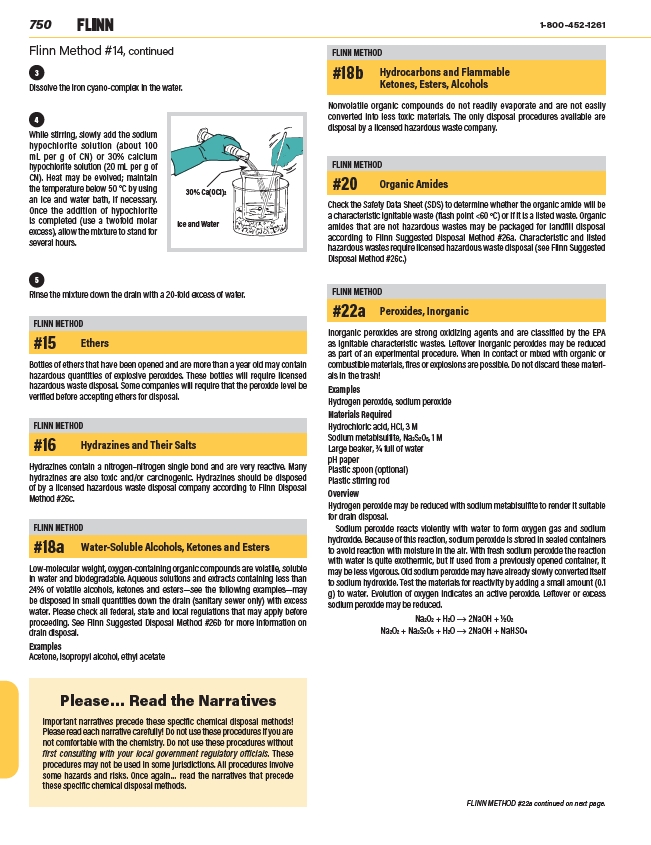
750 1-800-452-1261
3
Dissolve the iron cyano-complex in the water.
30% Ca(OCI)2
5
Rinse the mixture down the drain with a 20-fold excess of water.
FLINN METHOD
#16 Hydrazines and Their Salts
Hydrazines contain a nitrogen–nitrogen single bond and are very reactive. Many
hydrazines are also toxic and/or carcinogenic. Hydrazines should be disposed
of by a licensed hazardous waste disposal company according to Flinn Disposal
Method #26c.
FLINN METHOD
#18a Water-Soluble Alcohols, Ketones and Esters
Low-molecular weight, oxygen-containing organic compounds are volatile, soluble
in water and biodegradable. Aqueous solutions and extracts containing less than
24% of volatile alcohols, ketones and esters—see the following examples—may
be disposed in small quantities down the drain (sanitary sewer only) with excess
water. Please check all federal, state and local regulations that may apply before
proceeding. See Flinn Suggested Disposal Method #26b for more information on
drain disposal.
Examples
Acetone, isopropyl alcohol, ethyl acetate
FLINN METHOD
#18b Hydrocarbons and Flammable
Ketones, Esters, Alcohols
Nonvolatile organic compounds do not readily evaporate and are not easily
converted into less toxic materials. The only disposal procedures available are
disposal by a licensed hazardous waste company.
FLINN METHOD
#15 Ethers
Bottles of ethers that have been opened and are more than a year old may contain
hazardous quantities of explosive peroxides. These bottles will require licensed
hazardous waste disposal. Some companies will require that the peroxide level be
verified before accepting ethers for disposal.
FLINN METHOD #22a continued on next page.
Flinn Method #14, continued
FLINN METHOD
#20 Organic Amides
Check the Safety Data Sheet (SDS) to determine whether the organic amide will be
a characteristic ignitable waste (flash point <60 ºC) or if it is a listed waste. Organic
amides that are not hazardous wastes may be packaged for landfill disposal
according to Flinn Suggested Disposal Method #26a. Characteristic and listed
hazardous wastes require licensed hazardous waste disposal (see Flinn Suggested
Disposal Method #26c.)
FLINN METHOD
#22a Peroxides, Inorganic
Inorganic peroxides are strong oxidizing agents and are classified by the EPA
as ignitable characteristic wastes. Leftover inorganic peroxides may be reduced
as part of an experimental procedure. When in contact or mixed with organic or
combustible materials, fires or explosions are possible. Do not discard these materials
in the trash!
Examples
Hydrogen peroxide, sodium peroxide
Materials Required
Hydrochloric acid, HCl, 3 M
Sodium metabisulfite, Na2S2O5, 1 M
Large beaker, 3⁄4 full of water
pH paper
Plastic spoon (optional)
Plastic stirring rod
Overview
Hydrogen peroxide may be reduced with sodium metabisulfite
to render it suitable
for drain disposal.
Sodium peroxide reacts violently with water to form oxygen gas and sodium
hydroxide. Because of this reaction, sodium peroxide is stored in sealed containers
to avoid reaction with moisture in the air. With fresh sodium peroxide the reaction
with water is quite exothermic, but if used from a previously opened container, it
may be less vigorous. Old sodium peroxide may have already slowly converted itself
to sodium hydroxide. Test the materials for reactivity by adding a small amount (0.1
g) to water. Evolution of oxygen indicates an active peroxide. Leftover or excess
sodium peroxide may be reduced.
Na2O2 + H2O → 2NaOH + 1⁄2O2
Na2O2 + Na2S2O5 + H2O → 2NaOH + NaHSO4
4
While stirring, slowly add the sodium
hypochlorite solution (about 100
mL per g of CN) or 30% calcium
hypochlorite solution (20 mL per g of
CN). Heat may be evolved; maintain
the temperature below 50 °C by using
an ice and water bath, if necessary.
Once the addition of hypochlorite
is completed (use a twofold molar
excess), allow the mixture to stand for
several hours.
Ice and Water
Please… Read the Narratives
Important narratives precede these specific chemical disposal methods!
Please read each narrative carefully! Do not use these procedures if you are
not comfortable with the chemistry. Do not use these procedures without
first consulting with your local government regulatory
officials. These
procedures may not be used in some jurisdictions. All procedures involve
some hazards and risks. Once again… read the narratives that precede
these specific chemical disposal methods.